Humboldt State University
Humboldt State University (HSU, Humboldt State,[8] or Humboldt) is a public university in Arcata, California. It is the northernmost campus of the 23-school California State University (CSU) system. The main campus, situated hillside at the edge of a coast redwood forest, has commanding views overlooking Arcata, much of Humboldt Bay, and the Pacific Ocean. The college town setting on the California North Coast, 8 miles (13 km) north of Eureka, 279 miles (449 km) north of San Francisco, and 654 miles (1052.51 km) north of Los Angeles is notable for its natural beauty.
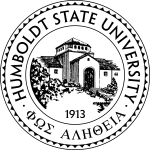 | |
Former names | Humboldt State Normal College (1913–35) Humboldt State College (1935–72) California State University, Humboldt (1972–74) |
|---|---|
| Motto | ΦΩΣ ΑΛΗΘΕΙΑ (Greek) |
Motto in English | Light Truth |
| Type | Public |
| Established | June 16, 1913 |
| Endowment | $30.3 million (2019)[1] |
| Budget | $220.8 million (2018)[2] |
| President | Tom Jackson, Jr. |
| Provost | Jenn Capps |
Academic staff | 574[3] |
| Students | 6,983 (Fall 2019)[4] |
| Undergraduates | 6,443 (Fall 2019)[4] |
| Postgraduates | 540 (Fall 2019)[4] |
| Location | , , United States |
| Campus | Rural, 144 acres (58 ha) main campus and nearly 591 acres (239 ha) of additional property[5] Total: 733 acres |
| Colors | Green and gold[6] |
| Athletics | NCAA Division II – California Collegiate Athletic |
| Nickname | Lumberjacks |
| Affiliations | California State University |
| Mascot | Lucky Logger[7] |
| Website | www |
 | |
The university is divided into three colleges: the College of Arts, Humanities, and Social Sciences; the College of Natural Resources and Sciences; and the College of Professional Studies.[9] It offers 48 types of bachelor's degrees, 12 different master's degrees, 61 minors, and 13 credential programs.[3] HSU does not offer doctoral degrees.
In addition to the main campus, HSU has multiple off-campus facilities and education-related properties, including an ocean-side marine biology research center,[10] a wildlife care facility,[11] a public natural history museum,[12] a public art gallery,[13] a bay-side aquatics facility,[14] a mountain-top astronomy observatory,[15] an ocean-going marine research and teaching vessel (Coral Sea),[16] and a demonstration forest (Arcata Community Forest).[17]
History

Humboldt State Normal School was established as a teacher's college on June 16, 1913, by then-California Governor, Hiram Johnson.[18] It was named after the famous German scientist Alexander von Humboldt. The cities of Arcata and Eureka (and to a lesser extent Fortuna[19]) competed with one another to host the new campus. Arcata eventually won the university when William Preston, and the Union Water company, donated 55-acres.[18] It opened on April 6, 1914 in the former Arcata Grammar School building with 78 students and 5 faculty. On May 26, 1915 the first commencement of the first graduating class occurred, a class of 15 women.[20] The first graduate awarded their degree in 1915 was local historian Susie Baker Fountain, who went on to catalog much of Humboldt County history from 1850-1966. Baker was a columnist for the Blue Lake Advocate and her extraordinary, lifelong collection of newspaper clippings and images are available for viewing in HSU Special Collections.[21]
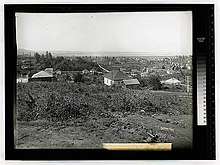
The school was put under the jurisdiction of the California Department of Education, renamed Humboldt State Teacher's College and Junior College, and moved to its current location in 1921. In 1924, during the presidency of Ralph Waldo Swetman, the Associated Students and the Alumni Association were organized and The Foghorn, the first student newspaper, was published. Bachelor's degrees began being offered in 1927. The school was renamed Humboldt State College in 1935 and the next year the Lumberjack was adopted as its mascot. In 1937, the students opened a cooperative bookstore and soda fountain, which would exist for the next 40 years as the center of student life.
During World War II, Arcata's city defense council suggested camouflaging Founder's Hall, which is visible from the Pacific Ocean, so it would not be a target for Japanese submarines. The council made its request in 1942, but Founder's Hall was not painted until the spring of 1944. The building remained camouflage green until 1948.[22] During WWII, President Arthur Gist corresponded back and forth with the hundreds of students who left Humboldt State College to serve in the war. Available for viewing in the Arthur Gist Letters at HSU Special Collections, there are over 1,000 letters from 365 servicemen and women writing to Gist for the duration of the war.[23]
Graduate programs began being offered in 1947. Under President Siemens in 1952, HSU continued expanding by accepting students from abroad, including some from Yugoslavia, Germany, the Near East as well as US territories such as Samoa, Guam and Hawaii. KHSC, later KHSU, the first state college radio station in California, was established. In 1960, the college joined the newly formed California State College system. The junior college program, terminated at HSU in 1962, was re-established in 1964 at College of the Redwoods (CR) located at the southern edge of Eureka. CR is located only seventeen miles south of HSU, and the two institutions maintain a close working relationship, with many students transferring to HSU following graduation from CR.
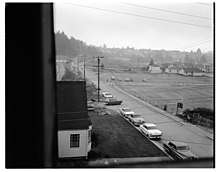
Student activism on campus rose through the 1960s and early 1970s, peaking in a protest against the Vietnam War with about 800 students (out of 3,600) participating in demonstrations on October 15, 1969. This was followed by another protest with nearly 3,000 students who planned a strike after the Cambodian Incursion. With similar events across the state, Governor Reagan shut down the CSC system in May 1970 for 5 days. The 1970s also saw the rise of feminist, cultural, and LGBT groups, and though the Women's Center would be the only one to survive through the 1980s, most groups would reappear by the mid-1990s.[22] The campus currently hosts a United Students Against Sweatshops group that is active in lobbying for ethical products and services on campus.
David Philips (HSU alum) established the Humboldt Film Festival in 1967. It is now one of the oldest student-run festival in the world.[22] In 1996 the annual Explorations in Afro-Cuban Dance and Drum workshop began being held on the campus every July. The workshop is the largest assemblage of Afro-Cuban folkloric masters in the United States, drawing students from across the country and around the world.
In 1972, the college was renamed California State University, Humboldt. However, it still continued to be popularly called "Humboldt State." Reflecting this, its name was simplified to Humboldt State University in 1974.[18] Enrollment first reached 7,500 in 1974, and though it has increased to near 8,000 in years since, the university remains one of the smallest in the CSU system. Through the 1980s, mature students became a large part of Humboldt State's student body, and in 1986 40% of the students were over the age of 25.[24] The number has since decreased to 30%.[25]
In 1987 students and activists founded the optional Graduation Pledge of Social and Environmental Responsibility. The purpose of the Pledge is to encourage graduating students to be mindful of the social and environmental impacts of their employment as they enter the workforce or continue their education. Today over one hundred Universities and colleges worldwide use the Pledge to some extent.[26]
Academics
| 2014 | 2013 | 2012 | 2011 | 2010 | 2009 | |
|---|---|---|---|---|---|---|
| Applicants | 11,912 | 11,261 | 9,976 | 9,417 | 9,207 | 9,418 |
| Admits | 9,119 | 8,514 | 8,050 | 8,768 | 7,278 | 7,135 |
| % Admitted | 76.55 | 76.06 | 80.69 | 93.10 | 79.04 | 75.75 |
| Avg GPA | 3.20 | 3.21 | 3.15 | 3.13 | 3.16 | 3.16 |
The university is divided into three colleges: the College of Arts, Humanities, and Social Sciences; the College of Natural Resources and Sciences; and the College of Professional Studies. There are 48 undergraduate majors and 69 minors.[31] The two largest majors are Biology and Art, both with over 20 faculty members and extensive facilities on- and off-campus. This CSU campus offers a Wildlife undergraduate degree. There are several credential programs and twelve Master's programs, of which Natural Resources and Social Work are the largest. The new Energy, Environment, and Society graduate program is unique to the CSU, and provides graduates with interdisciplinary training in engineering, economics, and climate policy.
The University Library supports students and faculty from all three academic colleges. Beginning in 2015, the Library launched HSU Press to showcase research and scholarship across the campus.[32] It also houses the Humboldt State University Press, which publishes theses, textbooks and trade books of interest to Humboldt State and the surrounding area. On campus, a popular major is Forestry. The Forestry department building's walls are completely paneled with different species of wood. The building was rebuilt in October 1980 after the original building was burned down. The original building only stood for 17 years before an arsonist, whose identity is still unknown today, set the building on fire in 1979.[33]
Humboldt State is one of only two universities in California to offer a major in botany, the other is California State Polytechnic University, Pomona. Its botany program is the nation's largest undergraduate program. Humboldt State is the only university in California to offer a degree in rangeland resources and wildland soil science.[34] The Native American Studies major and the Oceanography major are also unique to the California State University system. The university offers unique minors including multicultural queer studies, scientific diving, and appropriate technology.[31]
The university's location on the North Coast provides access to the Pacific Ocean, lagoons, marshes, estuaries, and the Fred Telonicher Marine Laboratory, which provides opportunities for "hands-on" experiences and research for the sciences. The Marine Lab was opened in 1966, the lab is open during the academic school year (mid August-mid May).[33]
Humboldt State University's fire science program teaches modern techniques for managing wildfire, and an advanced training program is offered for Forest Service employees and similar professionals.[35]
As of 2012, Humboldt State University has an International student population that has quadrupled in the last five years. The International English Language Institute has worked alongside HSU for 22 years to help international students gain academic English language skills to further their academic pursuits and business careers.
The College of eLearning, & Extended Ed (CEEE) is a self-supporting outreach department of Humboldt State University that provides a variety of academic, professional development and personal enrichment opportunities. While the CEEE programs are open to almost everyone, there is an emphasis on providing access to those community members who are not matriculated students at the university. Non-matriculated students may take some regular university courses through the CEEE Open University program. High school students may take regular HSU courses through the CEEE High School Concurrent Enrollment Program. Also, those aged 60 and over may take regular HSU classes through the Over 60 Program. There are also a variety of online degree programs offered through the college. The CEEE also offers a wide range of diverse and eclectic programs. Examples include music and art programs for children, the Osher Lifelong Learning Institute for those aged 50 and over, foreign language classes, travel-study programs, continuing education for teachers, MFT/LCSW, nurses, and law enforcement.
In 1998 Humboldt State University opened the HSU First Street Gallery in Old Town Eureka, expanding community access to the university's cultural and fine arts programs. In 2007, the university further expanded its presence in Eureka with the opening of the HSU Humboldt Bay Aquatic Center, a $4.5 million aquatic facility on the bay in Old Town Eureka. Future plans include a new HSU Bay and Estuarine Studies Center. This new facility will be closer to the Coral Sea (in 2012 docked at Woodley Island, Eureka), the only vessel in a U.S. educational institution solely dedicated to undergraduate research. The new facility would be considerably larger than the other existing facility, the Fred Telonicher Marine Laboratory in Trinidad, 20 miles (32 km) north.[36]
Humboldt State University Professor Steve Sillett has conducted groundbreaking research on redwood forest canopies and was featured in a 2009 cover story in National Geographic. He holds the Kenneth L. Fisher Chair in Redwood Forest Ecology, the only endowed chair in the world dedicated to a single tree species.[35]
Statistics
| * All levels, freshman through graduate | |
|---|---|
| African American | 3.5% |
| Asian American | 2.3% |
| Filipino American | 0.5% |
| Pacific Islander | 0.3% |
| White European Americans | 43.2% |
| Native American/American Indian | 1.2% |
| Mexican American/Chicano | 26.0% |
| Other Latino American | 8.1% |
| Multiracial Americans | 6.5% |
| Non-resident alien | 1.5% |
| Unknown | 6.8% |
Student demographics
As of fall 2018 Humboldt State has the largest enrollment percentage of Native Americans and the third largest enrollment percentage of Multiracial individuals in the Cal State system.[37]
Rankings
| University rankings | |
|---|---|
| National | |
| Forbes[39] | 623 |
| THE/WSJ[40] | 501-600 |
| Regional | |
| U.S. News & World Report[41] | 37 |
| Master's University class | |
| Washington Monthly[42] | 59 |
- Colleges With a Conscience: HSU is one of the colleges profiled in The Princeton Review's book, Colleges with a Conscience: 81 Great Schools with Outstanding Community Involvement. The school was selected because of its record of having excellent service-learning programs and its blending of academics with community work.[43]
- Universities-Master's (West): Top Schools U.S. News & World Report ranked HSU tied for 37th in the Regional Universities (West) category for 2020, and in the same category also ranked it tied for 14th best public school, tied at 21st best for veterans, tied for 41st best for social mobility, and 43rd for best value.[44]
Student life
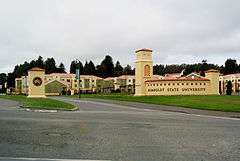
The Humboldt Energy Independence Fund (HEIF) is unique to the CSU, and uses student fee money to fund renewable energy and energy efficiency projects on campus. HEIF provides a rare opportunity for students, faculty, and plant operations staff to work together collaboratively towards a goal of a lower-carbon and energy-independent future. Compost and recycling bins are more common on campus than trash cans and many events are encouraged to be zero waste, all coordinated through the student-run Waste Reduction and Resource Awareness Program (WRRAP).[45] The Associated Students fund WRRAP, the Campus Center for Appropriate Technology, and the Sustainable Living Arts and Music Festival (SLAM fest).
Humboldt State University built the first building in the CSU system to be LEED-gold certified for its eco-friendly features. The Behavioral and Social Sciences Building has rainwater collection, sustainably harvested wood native-plant landscaping, and more.[35]
The location of HSU affords students the potential for outside activities in local parks and public lands, which include miles of accessible, undeveloped coastline. Rivers and streams, forests, and extraordinary terrain are just outside the classroom door.
There are over 200 clubs on campus that students can join. Clubs on campus include a variety of options that range from social interests, academic, Greek life and sports.[46]
Student media
The university has multiple publications. The Lumberjack is the university's only student-run weekly newspaper.[47]
The university also has a monthly student-run newspaper, El Leñador, which is bilingual and produced by students with minority backgrounds. It is a newspaper committed to promoting diversity in local media. El Leñador was named top non-weekly newspaper in the state. El Leñador received first place in competing against other monthly and bi-weekly papers from four- and two-year colleges and universities across California.[48]
Osprey is the university's student-run magazine, published twice annually. It has won first-place awards in major regional competitions, including the Society of Professional Journalists' "Mark of Excellence" Awards and the California Intercollegiate Press Association awards.[49]
Greek life
- Chi Phi fraternity-Epsilon Zeta Chapter
- Delta Phi Epsilon
- Gamma Alpha Omega Sorority- Pi Chapter
- Kappa Sigma fraternity – Tau Beta Chapter
- Lambda Theta Alpha Sorority - Epsilon Iota Chapter
- Lambda Theta Phi Fraternity- Beta Omega Chapter
Athletics
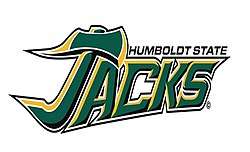
The Lumberjacks' program is affiliated with the NCAA on the Division II level and is a member of the California Collegiate Athletic Association. Humboldt State currently sponsors 12 intercollegiate sports programs — men's and women's soccer, basketball, cross country, track & field, women's volleyball, softball, rowing, and formerly, football (in which it competed in the Great Northwest Athletic Conference).
In addition to NCAA sanctioned athletics, Humboldt State also supports club sports including, Archery, Baseball, Cheer, Climbing, Cycling, Disc Golf, Fencing, Logging Sports, Men's and Women's Lacrosse, Men's and Women's Rugby, Men's and Women's Ultimate Frisbee, Men's Crew, and Men's Volleyball.
HSU's softball team has qualified for the NCAA post-season 18 times between 1990 and 2008, capturing the NCAA Division II Softball Championship in 1999 and in 2008.
- Women's (2)
- Softball (2): 1990, 2008
On-campus housing
On-Campus Housing consists of 6 living areas; The Hill, Cypress, Canyon, Creekview, College Creek and Campus Apartments. The north side of campus is consistent of The Hill, Cypress, The Canyon, and Creekview, which are considered primarily for first year traditional residents. The southside of campus, College Creek and Campus Apartments are placed for second year students, and non-traditional residents. College Creek consists of four three-level housing complexes separate. Each living area are monitored by Community Advocates, who are students which are employed by HSU housing and receive free housing if hired.[50]
Klamath Connection Program
The Klamath River is the focus of the Klamath Connection, which is designed to help freshmen learn important skills for future science careers.[51]
Y.E.S. House
The Y.E.S. House (Youth Educational Services) is programs created by students and led by students volunteer programs. The Y.E.S. House serves the communities needs. There are currently running 17 programs.[52] Students can volunteer for these programs and also have the ability to become directors as well.
Centers and institutes
Centers and institutes at the university include:
- The California Center for Rural Policy at Humboldt State University is a research center to assist policy development. community building community, and promoting the health of rural people and their environments.[53]
- The mission of the Humboldt Science and Mathematics Center is to enhance science and mathematics education. It was chartered in 2005, and offers programs and professional support for teachers and for students preparing for the professionals. The Center is formally affiliated with a number of University programs.[54]
- The Humboldt Institute for Interdisciplinary Marijuana Research (HIIMR) seeks to improve the economic, social, physical, and environmental health of individuals and communities through the interdisciplinary scientific study of marijuana. HIIMR designs, conducts, analyzes, and disseminates research; provides applied expertise to policy makers, researchers, health professionals, businesses, and the media; and archives and provides access to source materials (raw data, media).[55][56][57]
- Affiliated with the Department of Geography and its Kosmos Lab for teaching cartography, the Institute for Cartographic Design provides cartography students with an opportunity to engage in applied map design before graduation, provides a centralized cartographic design service on campus, in all formats from paper to web to animation.[58]
- The Institute of Health and Human Performance supports the local community in activities for health promotion. It supports research and training for faculty and students in health, human performance, disease prevention, physical activity and nutrition.[59]
- The Institute for Entrepreneurship Education is designed to reach other academic departments on campus as well as the Redwood Coast business community. It is oriented around interdisciplinary study, with a focus on social entrepreneurship and an ethic of social responsibility.[60]
- The Humboldt State University Institute for Spatial analysis (ISA) is devoted to the expansion of spatial analysis methodologies in multiple disciplines and the real world issues. It works with both public and private sector entities.[61]
- The Schatz Energy Research Center (SERC) works to establish clean energy technology. It specializes in renewable energy, energy efficiency, and hydrogen energy systems, especially increasing the efficiency of fuel cells. Its work involves research and development, technology demonstration, project development, energy systems analysis, and education and training.[62]
Notable people
Alumni
- Taylor Boggs, professional football player currently playing for the Arizona Cardinals
- Melissa Braden, sculptor and ceramic artist
- Mark Conover, winner of 1988 Olympic Marathon trials[63]
- Dean L. Bresciani, President of North Dakota State University
- Ellie Cachette, American technology executive, activist and author
- Alex Cappa, professional football player currently playing for the Tampa Bay Buccaneers
- Raymond Carver, American short story writer and poet
- Michael Crooke, businessman, former CEO of Patagonia, Inc.
- Dan Curry, Emmy Award winner for work on Star Trek
- Chris Dixon, indoor football player
- Trevor Dunn, bassist for Mr. Bungle and Fantomas
- Jack Fimple, former Major League Baseball catcher
- Ken Fisher, billionaire CEO of Fisher Investments, long-time Forbes columnist, and author of books on investing
- Harrell Fletcher, artist
- David Gelbaum, businessman, green technology investor and environmental philanthropist
- Dave Harper, former NFL linebacker
- Wendell Hayes, former NFL running back
- Danny Herrera, former powerlifter
- Stephen Hillenburg, creator of Nickelodeon's SpongeBob SquarePants
- John Kiffmeyer, former drummer for the rock band Green Day
- Jeffrey D. Levine, former United States Ambassador to Estonia
- Clinton McKinnon, Mr. Bungle musician
- Kassandra McQuillen, attorney and contestant on Survivor: Cagayan and Survivor: Cambodia
- Michael Moore, member of the Instant Composers Pool
- Mike Patton, musician, notable for his work with Faith No More, Mr. Bungle, and film scoring
- Steve Selva, botanist and Professor Emeritus at the University of Maine
- Monroe Spaght, research chemist, president and chairman of the Shell Oil Company
- Marla Spivak, entomologist and professor at the University of Minnesota
- Trey Spruance, Mr. Bungle and Secret Chiefs 3 musician
- Josh Suggs, current Major League Soccer Defender; Colorado Springs Switchbacks FC
- Micah True, ultrarunner and founder of the Ultramaraton Caballo Blanco
- Martin Wong, American painter and ceramist
Faculty
- Don Gregorio Antón, Artist/Educator (Emeritus Professor)
- Jim Dodge, novelist and poet
- Stephen Fox (emeritus), historian, author, and educator
- Robert A. Gearheart (emeritus), environmental engineer[64]
- Victor Golla, (emeritus), linguist
- Steven C. Hackett, economist[64]
- Eric Rofes, gay activist, feminist, educator, and author
- Stephen C. Sillett, botanist[64]
See also
- List of forestry universities and colleges
- Campus Center for Appropriate Technology (CCAT)
- Humboldt Institute for Interdisciplinary Marijuana Research (HIIMR)
- Humboldt State University Natural History Museum
References
- As of June 30, 2019. "U.S. and Canadian 2019 NTSE Participating Institutions Listed by Fiscal Year 2019 Endowment Market Value, and Percentage Change in Market Value from FY18 to FY19 (Revised)". National Association of College and University Business Officers and TIAA. Retrieved April 22, 2020.
- https://hsu.openbook.questica.com/#/visualization/2c821a3c-dced-42ea-b598-97058ab8ed13
- "About Humboldt State University". Humboldt State University. Retrieved September 15, 2019.
- "Fall Term Student Enrollment". The California State University Institutional Research and Analyses. Retrieved November 18, 2019.
- "Fast Facts". Humboldt State University. Retrieved September 15, 2019.
- "Visual Identity | HSU Brand". Archived from the original on July 15, 2018. Retrieved July 15, 2018.
- "HSU Library – Special Collections – Humboldt State Chronology". Archived from the original on October 10, 2008. Retrieved August 23, 2008.
- "Campus Names". calstate.edu. California State University. Archived from the original on June 14, 2014. Retrieved May 30, 2014.
- "HSU Colleges, Departments, Study Fields, and Majors". pine.humboldt.edu. Archived from the original on February 15, 2016. Retrieved February 8, 2016.
- "HSU Marine Laboratory". www2.humboldt.edu. Archived from the original on February 1, 2016. Retrieved February 8, 2016.
- "Marine Wildlife Care Center". www2.humboldt.edu. Archived from the original on September 5, 2015. Retrieved February 8, 2016.
- "Natural History Museum". www2.humboldt.edu. Archived from the original on February 9, 2016. Retrieved February 8, 2016.
- "Department of Art | Humboldt State University". www2.humboldt.edu. Archived from the original on November 7, 2015. Retrieved February 8, 2016.
- "Humboldt Bay Aquatic Center | HSU Center Activities". www2.humboldt.edu. Archived from the original on February 19, 2016. Retrieved February 8, 2016.
- "Facilities | Department of Physics & Astronomy". www2.humboldt.edu. Archived from the original on October 4, 2015. Retrieved February 8, 2016.
- "HSU Marine Laboratory | Research Vessel". www2.humboldt.edu. Archived from the original on December 8, 2015. Retrieved February 8, 2016.
- "Arcata Stay | Humboldt State University is located in the city of Arcata, California". Arcatastay.com. Archived from the original on April 1, 2015. Retrieved March 31, 2015.
- "Humboldt State University: A Brief History – Centennial – Humboldt State University". www2.humboldt.edu. Archived from the original on October 11, 2015. Retrieved February 8, 2016.
- Van Kirk, Susie (January 1979). Reflections of Arcata's History: eighty years of architecture. Bug Press.
- Tahja, Katy (2010). Humboldt State University. San Francisco, CA: Arcadia Publishing. p. 15. ISBN 978-0-7385-8015-9.
- Susie Baker Fountain Papers. Arcata, CA: Humboldt State University Special Collections, Humboldt State University.
- Tanner, William (1993). A View from the Hill. Humboldt State University, Arcata, California: University Graphic Services.
- Arthur Gist Letters. Arcata, CA: Humboldt State University Special Collections, Humboldt State University.
- Tanner, 135–144
- "Analytic Studies: University Statistical Profile". Humboldt.edu. Archived from the original on May 28, 2010. Retrieved March 31, 2015.
- "History | Graduation Pledge Alliance". Graduationpledge.org. Archived from the original on March 19, 2015. Retrieved March 31, 2015.
- "Applicants reports". Pine.humboldt.edu. Archived from the original on April 2, 2015. Retrieved March 31, 2015.
- "General Information" (PDF). Pine.humboldt.edu. Archived (PDF) from the original on December 17, 2013. Retrieved March 31, 2015.
- "Fall Applications for Admission Submitted via CSU Mentor" (PDF). Calstate.edu. Archived from the original (PDF) on September 23, 2015. Retrieved March 31, 2015.
- "Data Center". Humboldt.edu. Archived from the original on July 19, 2014. Retrieved August 18, 2014.
- "Majors & Programs | Humboldt State University". Humboldt.edu. Archived from the original on July 1, 2014. Retrieved March 31, 2015.
- "HSU Launches University Press – Humboldt State Now". now.humboldt.edu. Archived from the original on January 28, 2016. Retrieved January 19, 2016.
- Tahja, Katy (2010). Humboldt State University. San Francisco, CA: Arcadia Publishing. p. 89. ISBN 978-0-7385-8015-9.
- "Department of Forestry & Wildland Resources—Humboldt State University". Humboldt.edu. Archived from the original on April 15, 2015. Retrieved March 31, 2015.
- "Humboldt State University | The Impact of the California State University". Calstate.edu. Archived from the original on April 21, 2015. Retrieved March 31, 2015.
- "On the Cover – North Coast Journal – April 21, 2005 – Out with the tide? As administrators mull a move for Telonicher, Humboldt State faculty protect their Trinidad turf". North Coast Journal. April 21, 2005. Archived from the original on November 2, 2015. Retrieved March 31, 2015.
- "Ethnicity Enrollment Profile". www.calstate.edu. Retrieved July 9, 2019.
- "General Information" (PDF). Pine.humboldt.edu. Archived (PDF) from the original on March 4, 2016. Retrieved March 31, 2015.
- "America's Top Colleges 2019". Forbes. Retrieved August 15, 2019.
- "U.S. College Rankings 2020". Wall Street Journal/Times Higher Education. Retrieved September 26, 2019.
- "Best Colleges 2020: Regional Universities Rankings". U.S. News & World Report. Retrieved September 8, 2019.
- "2019 Rankings -- Masters Universities". Washington Monthly. Retrieved September 8, 2019.
- "Regional Universities (West) – Humboldt State University". U.S. News & World Report. Retrieved September 15, 2019.
- "Waste-Reduction & Resource Awareness Program (WRRAP) | Humboldt State University". www2.humboldt.edu. Archived from the original on November 27, 2015. Retrieved December 2, 2015.
- "HSU Clubs & Activities • Club Directory". www2.humboldt.edu. Archived from the original on October 11, 2015. Retrieved October 7, 2015.
- "The Lumberjack | Journalism & Mass Communication". journalism.humboldt.edu. Retrieved September 15, 2019.
- "El Leñador". www.facebook.com. Archived from the original on January 5, 2016. Retrieved December 10, 2015.
- "Society of Professional Journalists | Mark of Excellence Awards". Spj.org. Archived from the original on September 12, 2014. Retrieved August 18, 2014.
- "Housing & Residence Life". www2.humboldt.edu. Archived from the original on April 14, 2016. Retrieved April 13, 2016.
- "Klamath Connection Program". Archived from the original on March 5, 2016. Retrieved February 25, 2016.
- "Y.E.S. House". Archived from the original on April 27, 2016. Retrieved April 13, 2016.
- "CCRP". Humboldt.edu. Archived from the original on March 18, 2015. Retrieved March 31, 2015.
- "Humboldt Science and Mathematics Center". Humboldt.edu. September 9, 2011. Archived from the original on March 30, 2015. Retrieved March 31, 2015.
- Schmidt, Peter (June 3, 2013). "Legalize It and They Will Analyze It – The Chronicle Review – The Chronicle of Higher Education". Chronicle.com. Archived from the original on July 15, 2018. Retrieved March 31, 2015.
- "Humboldt Institute for Interdisciplinary Marijuana Research (HIIMR) Charter | HSU Forms". Humboldt.edu. November 28, 2012. Archived from the original on April 2, 2015. Retrieved March 31, 2015.
- "HiiMR". Humboldt.edu. Archived from the original on April 2, 2015. Retrieved March 31, 2015.
- "Kosmos Cartography". Humboldt.edu. Archived from the original on March 3, 2015. Retrieved March 31, 2015.
- "The Institute of Health and Human Performance | Humboldt State University Department Kinesiology & Recreation Administration". www2.humboldt.edu. Archived from the original on December 8, 2015. Retrieved December 2, 2015.
- "Current Centers & Institutes | Office of Research, Economic & Community Development". www2.humboldt.edu. Archived from the original on September 5, 2015. Retrieved December 2, 2015.
- "Institute for Spatial Analysis – Humboldt State University". Humboldt.edu. Archived from the original on March 3, 2015. Retrieved March 31, 2015.
- "Schatz Energy Research Center". Schatzlab.org. Archived from the original on April 3, 2015. Retrieved March 31, 2015.
- Tanner, William R. (1993). A View From the Hill. Humboldt State University, Arcata, California: University Graphic Services. p. 130.
- Archived May 29, 2010, at the Wayback Machine
External links
| Wikimedia Commons has media related to Humboldt State University. |